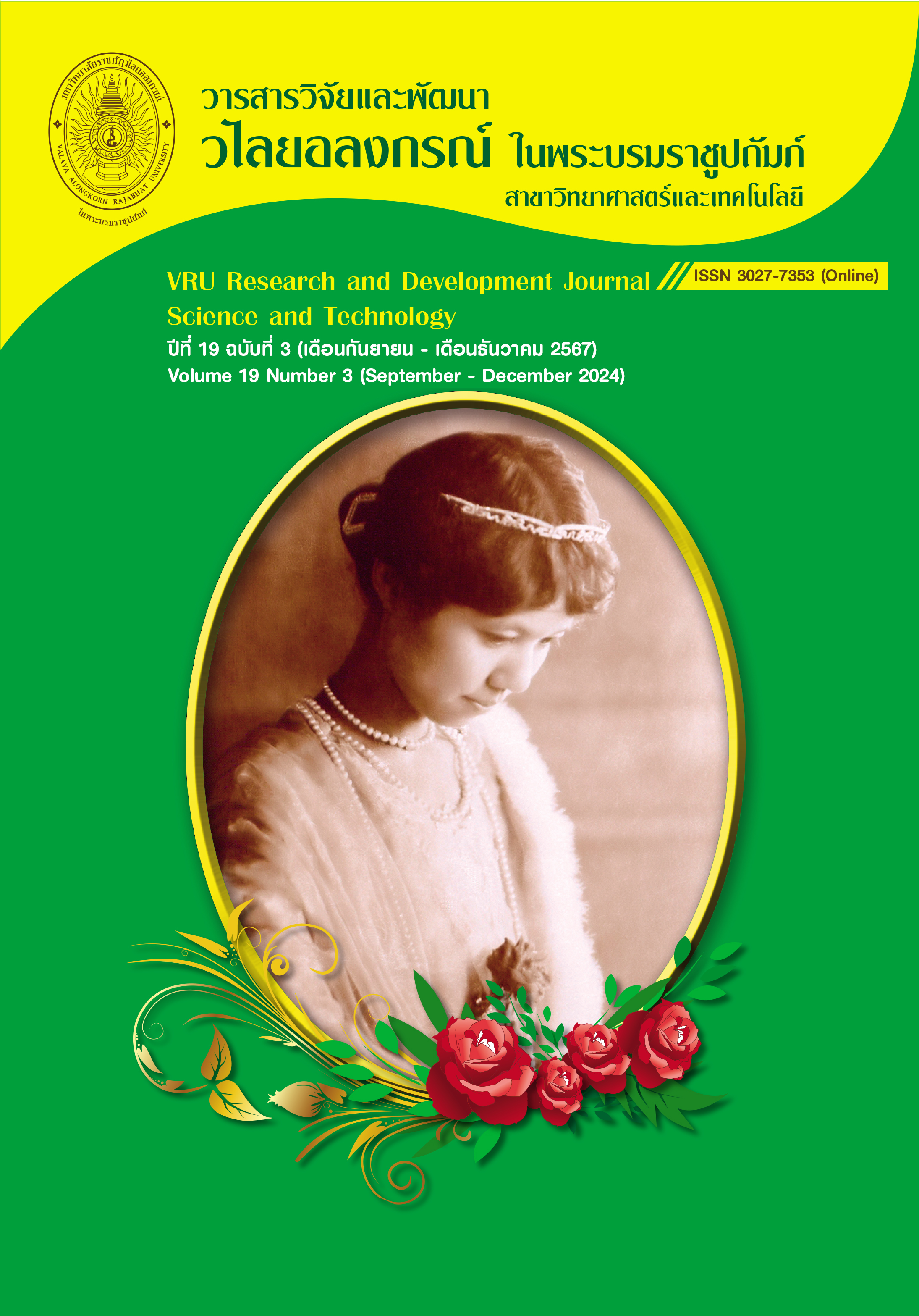EFFECTS OF CRUDE EXTRACT FROM DERRIS ELLIPTICA BENTH. ON THE CONTROL OF COMMON CUTWORM (Spodoptera litura Fabricius)
Main Article Content
Abstract
This research aimed to study the effectiveness of controlling common cutworms using crude extracts from the roots, leaves, and stems of Derris elliptica Benth. extracted with ethanol at various concentrations (0.5, 1, 4, 8, and 10% w/v). It was found that the crude extract from Derris elliptica Benth. roots at a concentration of 10% w/v caused the most common cutworm deaths within 7 days, up to 40%. This was followed by extracts from the leaves and stems, causing 30% and 20% mortality, respectively. In feeding tests, the crude extract from the roots showed a high antifeeding effect on common cutworms, with a percent antifeedant index (% AFI) of 45.81. The crude extracts from the leaves and stems had % AFIs of 31.21 and 10.67, respectively. These experimental results demonstrated that the crude extracts from the roots, leaves, and stems of Derris elliptica Benth. at a 10% w/v concentration were the most effective in causing deaths of common cutworms within 7 days. These extracts could potentially be used to control pest insects as an alternative to chemical pesticides in agriculture.
Downloads
Article Details
ลิขสิทธิ์บทความวิจัยที่ได้รับการตีพิมพ์เผยแพร่ในวารสารวิจัยและพัฒนา วไลยอลงกรณ์ ในพระบรมราชูปถัมภ์ ถือเป็นกรรมสิทธิ์ของสถาบันวิจัยและพัฒนา มหาวิทยาลัยราชภัฏวไลยอลงกรณ์ ในพระบรมราชูปถัมภ์ ห้ามนำข้อความทั้งหมดหรือบางส่วนไปพิมพ์ซ้ำ เว้นแต่จะได้รับอนุญาตจากมหาวิทยาลัยเป็นลายลักษณ์อักษร
ความรับผิดชอบ เนื้อหาต้นฉบับที่ปรากฏในวารสารวิจัยและพัฒนา วไลยอลงกรณ์ ในพระบรมราชูปถัมภ์ เป็นความรับผิดชอบของผู้นิพนธ์บทความหรือผู้เขียนเอง ทั้งนี้ไม่รวมความผิดพลาดอันเกิดจากเทคนิคการพิมพ์
References
กุลชาติ บูรณะ, และประกายจันทร์ นิ่มกิ่งรัตน์. (2563). พฤติกรรมการใช้สารฆ่าแมลงเพื่อควบคุมแมลงศัตรูดาวเรืองของเกษตรกรในพื้นที่จังหวัดขอนแก่นและมหาสารคาม. วารสารแก่นเกษตร, 48(4),
-726.
จักรพงษ์ สุภาวรรณ์, ดาวพระศุกร์ เอกชัยวีรกูล, ศราวดี แสนศรี, และณัฐดนัย ลิขิตตระการ. (2564).
ความเป็นพิษของสารสกัดหยาบจากพืชที่มีผลต่อหนอนกระทู้ผัก (Spodoptera litura Fabricius). วารสารผลิตกรรมการเกษตร, 3(1), 1-11.
วาสนา สอนเพ็ง, สุภาณี พิมพ์สมาน, และฉันทนา อารมณ์ดี. (2552). ฤทธิ์ฆ่าแมลงของสารสกัดจากหนอนตายหยาก (Stemona tuberosa Lour). วารสารวิจัย มหาวิทยาลัยขอนแก่น, 14(2), 112-122.
สมบูรณ์ แสงมณีเดช, ขวัญเกศ กนิษฐานนท์, ตรองรัก บุญเติม, ทศพล จุฬาลักษณานุกูล, ทินกร แสงงาม, ทิพย์วรรณ สอนง่ายดี, และธนิดา วังคำ. (2547). ประสิทธิภาพของรากหางไหลสดและสารสกัดในการควบคุมลูกน้ำยุง. วารสารสัตวแพทยศาสตร์ มหาวิทยาลัยขอนแก่น, 14(1), 87-93.
สมบูรณ์ แสงมณีเดช, ขวัญเกศ กนิษฐานนท์, พิทยา ภาภิรมย์, และธานี เทศศิร. (2548). การใช้พืชสมุนไพร(หางไหล) ควบคุมประชากรหนอนแมลงวันและการประยุกต์ใช้รักษาภาวะไมเอียซิสผิวหนังในสัตว์. วารสารวิจัยมหาวิทยาลัยขอนแก่น, 10(1), 22-30.
สาโรจ เจริญศักดิ์, และจรงค์ศักดิ์ พุมนวน. (2550). ประสิทธิภาพของสรสกัดจากพืชสมุนไพรพื้นบ้านของภาคตะวันออกเฉียงเหนือในการควบคุมหนอนกระทู้ผัก Spodopetera litula (F.). รายงานการวิจัย มหาวิทยาลัยเทคโนโลยีราชมงคลกรุงเทพ.
สุขสม ศรีจักรวาฬ, อรนุช เกษประเสริฐ, ปราโมทย์ เกิดศิริ, และนพรัตน์ หยีดจันทร์. (2536). การเจริญเติบโตและปริมาณสารพิษในต้นหางไหล (โล่ติ๊น) เมื่ออายุต่างๆกัน. รายงานการสัมมนาการใช้สารจากพืชเพื่อป้องกัน กำจัดศัตรูทางการเกษตร. ขอนแก่นการพิมพ์. (หน้า 25-35).
สุเทพ สหายา, และลักขณา บำรุงศรี. (2546). โรติโนนสารสกัดจากพืชที่มีต่อแมลง. วารสารกีฎและสัตววิทยา, 25(4), 295-298.
สุภาณี พิมพ์สมาน, รัตนาภรณ์ พรหมศรัทธา, และสังวาล สมบูรณ์. (2546). สารสกัดจากหนอนตายอยาก (Stemona sp.) เพื่อการควบคุมแมลงศัตรูพืช. การประชุมวิชาการอารักขาพืชแห่งชาติครั้งที่ 6 โรงแรมโซฟิเทลราชาออคิดขอนแก่น วันที่ 24-27 พฤศจิกายน 2546. (หน้า 22).
อภิชัย เปรมัษเฐียร, และสมสุข ศรีจักรวาฬ. (2542). โล่ติ๊นหรือหางไหล สมุนไพรพื้นบ้านในการกำจัดแมลงที่น่าสนใจ(2). วารสารเคหการเกษตร, 23(7), 156-158.
อารมณ์ แสงวนิชย์, และอุดมลักษณ์ อุ่นจิตต์วรรธนะ. (2542). โล่ติ๊นหรือหางไหล สมุนไพรพื้นบ้านในการกำจัดแมลงที่น่าสนใจ. วารสารเคหการเกษตร, 23(7), 184-188.
Abbott, W.S. (1925). A method of computing the effectiveness of an insecticide. Journal Economic Entomology, 18(2), 265-267.
Bomford, M.K., & Isman M.B. (1996). Desensitization of fifth instar Spodoptera litura (Lepidoptera Noctuidae) to azadirachtin and neem. Entomologia Experimentalis et. Applicata. 81, 307-313.
Cheraghi, N.M., Farzaei, M.H., Razkenari, E.K., Aamin, G., Khanavi, M., Akbarzadeh, T. & Shams-Ardekani, M.R. (2016). An evidence-based review on medicinal plants used as insecticide and insect repellent in traditional Iranian medicine An Evidence-Based Review on Medicinal Plants Used as Insecticide and Insect Repellent in Traditional Iranian Medicine. Iranian Red Crescent Medical Journal, 18(2), 1-8.
Dey, K.R., Choudhury, P., & Dutta, B.K. (2013). Impact of pesticide use on the health of farmers: A study in Barak Valley, Assam (India). Journal of Environmental Chemistry and Ecotoxicology, 5, 269-277.
Escoubas P., Lajide, L., & Mitzutani, J. (1993). An improved leaf-disk antifeedant bioassay and its application for the screening of Hokkaido plants. Entomological Experrimentalis et Applicata. 66(2), 99-107.
Huang, Y. H., Ho, S. H., Lee, H.C., & Yap, Y.L. (2002). Insecticidal properties of eugenol, isoeugenol and methyleugenol and their effects on nutrition of Sitophilus zeamais Motsch. (Coleoptera: Curculionidae) and Tribolium castaneum (Herbst) (Coleoptera: Tenebrionidae). Journal of Stored Products Research, 38, 403-412.
Hummelbrunner, L.A., & Isman, M.B. (2001). Acute, sublethal, antifeedant, and synergistic effects of monoterpenoid essential oil compounds on the tobacco cutworm, Spodoptera litura (Lepidoptera: Noctuidae). Journal of Agricultural and Food Chemistry, 49, 715-720.
Moon, Y., Lee, K.H., Park, J.H., Geum, D., & Kim, K. (2005). Mitochondrial membrane depolarization and the selective death of dopaminergic neurons by rotenone: protective effect of coenzyme Q10. Journal Neurochemistry, 93(5), 1199-1208.
Ware, G.W. (1983). Pesticides: theory and application. WH Freeman & Co. New York. (pp 53).

